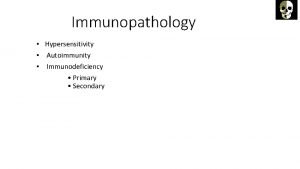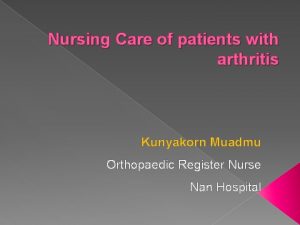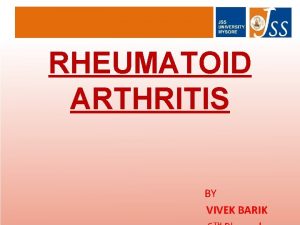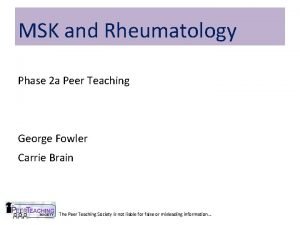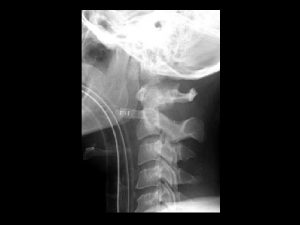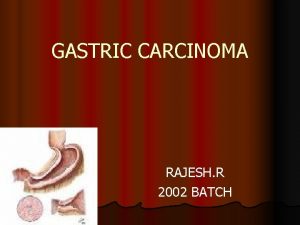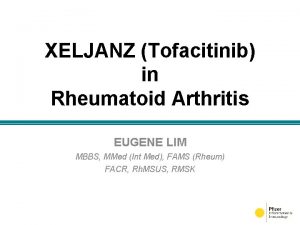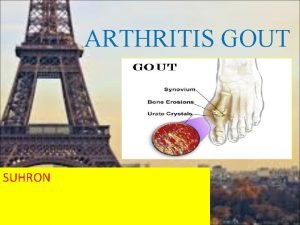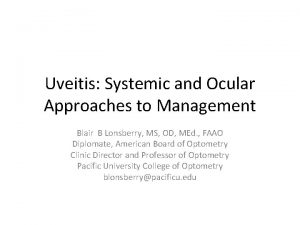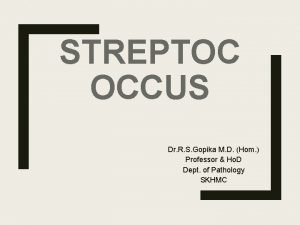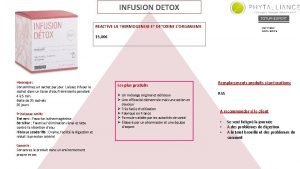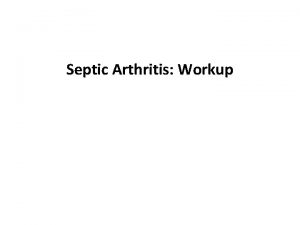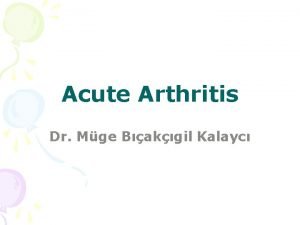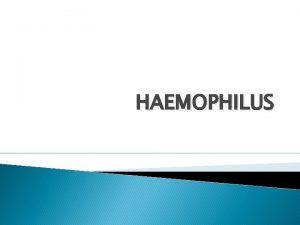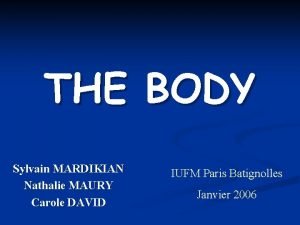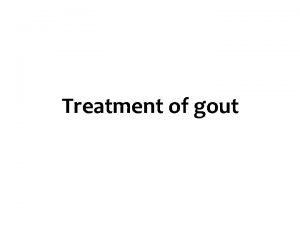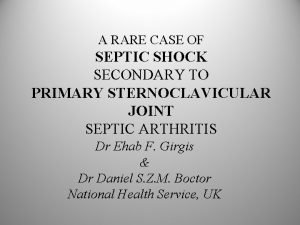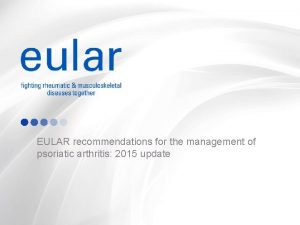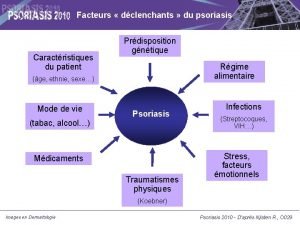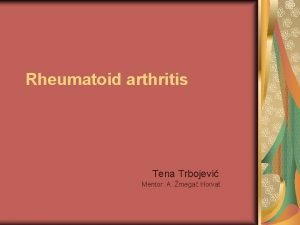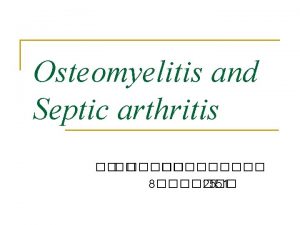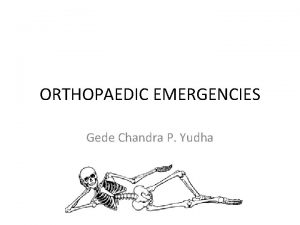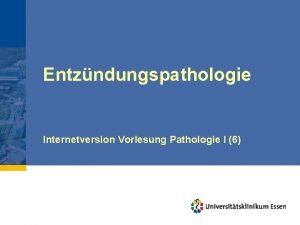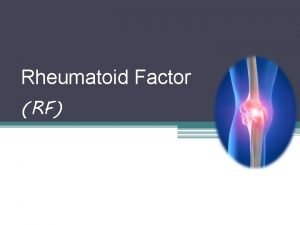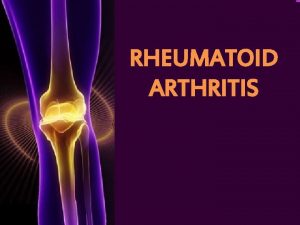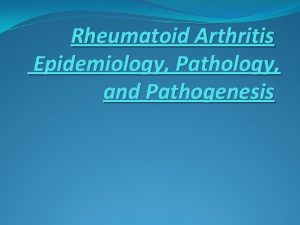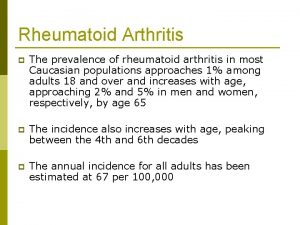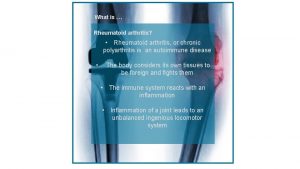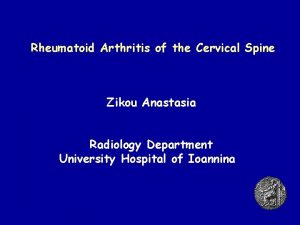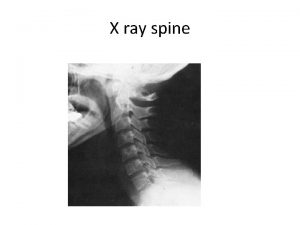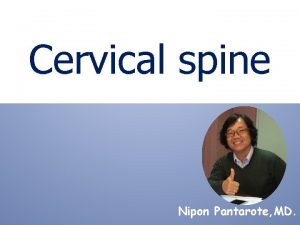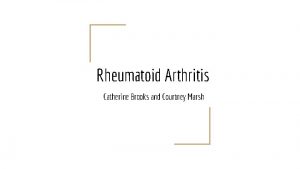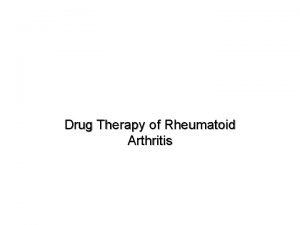Cervical Spine Surgery For Patients with Rheumatoid Arthritis














































- Slides: 46

Cervical Spine Surgery – For Patients with Rheumatoid Arthritis Wayne Cheng, MD. Assistant professor Department of Orthopaedic Surgery Loma Linda University Medical Center

Outline ¨ The most common abnormalities. ¨ Clinical Presentation. ¨ Radiological Evaluation. ¨ Natural History. ¨ Predictor of progression and recovery. ¨ Indication for surgery ¨ Surgical Considerations

Incidence ¨ RA affects 1% of adult population in US. ¨ C-spine is the second most common skeletal manifestation (15 -86%). ¨ Up to 26% of in-patients with RA may need surgical intervention. ¨ Three most common abnormalities: – 1. AAS – 2. AAI – 3. SAS

Atlantoaxial Subluxation (AAS) ¨ Most common – (43 -86%) ¨ Transverse ligament. ¨ Ant, lateral, posterior.

Atlantoaxial Impaction ¨ Second most frequent – (5 -34%) ¨ Other names – – Basilar invagination Cranial settling Vertical subluxation Superior migration. ¨ Joint incompetent: Result from bone and cartilage loss. ¨ Impinge on the brain stem.

Subaxial Subluxation ¨ 10 -25%. ¨ Most frequent: – C 23, C 34. ¨ Incompetent ligaments, facets. ¨ “Staircase”

Clinical Presentation ¨ ¨ #1: Pain(40 -88%) #2: Neuro(7 -34%) #3: Sudden death (10%) Earliest signs – Pain & neck stiffness ¨ High index of suspicion – Change in ambulation. – Long tract sign. – Vertebrobasilar SX. • Loss of equilibrium • Tennitus, vertigo, diplopia • Visual distrubances

Sudden Death in RA ¨ Post mortem study- 11 consecutive cases of atlanto-axial dislocation (104 patients total). ¨ Sudden death – 7 out 11 ¨ Correct diagnosis – 2 out 11 ¨ Spastic SX – only in 4/11 patients. ¨ Conclusion: – 1. 10% incidence of fatal medulla compression. – 2. Neurological signs are not helpful to point out the risk of fatal cord compression. Miculowski et al. , Acta Med. Scand, 1975

Ranawat Classification ¨I No neural deficit. ¨ II Subjective weakness/dysesthesia ¨ III Objective weakness/long-tract signs. • IIIA ambulatory • IIIB not ambulatory Ranawat et al, JBJS 1979 Vol 61 A-7

Radiological Eval - AAS ¨ Need flexion lateral. ¨ Normal is 3 mm. ¨ >10 – 12 mm = complete disruption ¨ Not reliable – May decrease as odontoid moves superiorly.

Radiologic Eval - AAS ¨ PADI ¨ >14 mm = 94% negative predictive value. ¨ Different than space available for the cord.

Radiologic Eval – AAS MRI neutral vs. flexion

Radiologic Eval - AAI ¨ Ranawat’s distance– distance between transverse axis of C 1 and middle of pedicle of C 2. ¨ Abnormal if: – Male < 15 mm. – Female < 13 mm.

Radiologic Eval. - AAI ¨ Mc. Greggor’s line. ¨ Line from hard palate to occipt. ¨ Abnormal if dens > 4. 5 mm above the line.

Radiologic Eval - AAI ¨ Redlund-Johnell ¨ Distance between Mc. Gregor’s line and inferior end plate of C 2. ¨ Abnormal if male < 34 mm and female < 29 mm.

Radiologic Eval - AAI ¨ Clark Station ¨ Divide C 2 into thirds on sagittal plan. ¨ Abnormal if the middle or lower third of C 2 is at the level of arch of C 1. I II III

Radiologic Eval - AAI ¨ The most specific: Redlund-Johnell (76%) ¨ The most sensitive: Clark Station (83%) ¨ To achieve > 90% sensitivity+specificity – Use combination of Clark station + Redlund-Johnell + Ranawat ¨ When in doubt – get a MRI. Riew et al. JBJS 83 A(2). 2001

Natural History ¨ Without cervical myelopathy ¨ With Cervical myelopathy.

Natural History – without myelopathy ¨ Prospective Study of 106 patients over 5 years. ¨ 80% had radiographic progression. ¨ 36% had neurologic deterioration. ¨ Only 10% required surgery. Pellicci et al. JBJS 63 A(3) 1981

Natural History – with myelopathy ¨ Sunahara, Spine ¨ Meijers, Clinical and 22(22), 1997 ¨ 21 pt with AAS, refused surgery. ¨ All patients bedridden within 3 years. ¨ 7 patients had sudden death. Exp Rheu, 1984 ¨ 9 patients. ¨ All 9 patients died within a year. ¨ 4 due to consequences of cord compression.

Natural History ¨ Without cervical myelopathy ¨ With Cervical myelopathy. Good Bad Predictor

Predictor of Paralysis ¨ PADI < 14 mm. ¨ Cervicomedullary angle less than 135 degree. ¨ SAC < 13 mm on MRI ¨ Cord diameter < 6 mm.

Predictor of Recovery ¨ Boden: – No recovery if PADI < 10 mm. – At least one neuro. Class improvement if PADI > 10 mm. ¨ Klein: – Duration of SX. ¨ Casey: – Pre-op neuro. Function, cord area, degree of AAI.

Indications for Surgery ¨ Accepted: – Intractable pain. – Progressive neurologic impairment. – Presence of myelopathy ¨ Controversial: – impending neurologic deficit. • Arguments for and against.

Surgical Consideration ¨ Frail. ¨ Malnourished. ¨ Osteoporotic. ¨ Immunosuppressed.

Preoperative Cervical Traction ¨ Used for AAI and severe subluxation. ¨ Goal: reduce subluxation and relieve compression. ¨ Advantages.

Airway Management ¨ Awake fiberoptic-assisted intubation Vs. traditional. ¨ 128 patients with RA. ¨ Upper-airway obstruction after extubation decrease from 14% to 1%. Wattenmaker et al. JBJS 76 -A(3), 1994

Decompression ¨ Persistent neurologic deficit despite traction. ¨ Level depend on location – of cord impingement. ¨ Controversial.

Stabilization Include all unstable levels.











Complication

Complication

Complication

Surgical Outcomes Year Author #patients Pain relief% Neuro. Improv % 2001 Asselt 31 62% 67% 1999 Grob 39 96 77 1998 Eyres 26 92 89 1998 Mori 25 96 67 1989 Clark 41 91 27 1987 Sakou 16 100 1985 Menezes 45 100

CONCLUSION ¨ High index of suspicion ¨ Majority of RA does not require surgery. ¨ Surgical indication: – Intractable pain – Progressive neurologic deficit – Myelopathy – Impending neurologic deficit? ¨ Careful surgical planning/team approach.


THANK YOU
 Nursing management of osteoarthritis
Nursing management of osteoarthritis B t cells
B t cells Rheumatoid arthritis extra-articular manifestations
Rheumatoid arthritis extra-articular manifestations Nursing diagnosis for rheumatoid arthritis
Nursing diagnosis for rheumatoid arthritis Dermatomyocytis
Dermatomyocytis Rheumatoid arthritis
Rheumatoid arthritis Caplan syndrome
Caplan syndrome Pictures of rheumatoid arthritis vs osteoarthritis
Pictures of rheumatoid arthritis vs osteoarthritis Z line deformity
Z line deformity Abatacept
Abatacept Barik meaning
Barik meaning Steinbrocker stage
Steinbrocker stage Spondyloarthropathy
Spondyloarthropathy What is subluxation
What is subluxation Haart side effects
Haart side effects Cervical spine reflexology
Cervical spine reflexology Pyloric adenoma
Pyloric adenoma Tofacitinib
Tofacitinib Anatomi fisiologi gout arthritis
Anatomi fisiologi gout arthritis Urethritis reactive arthritis
Urethritis reactive arthritis Gardening with arthritis
Gardening with arthritis Viral arthritis
Viral arthritis Reactive arthritis
Reactive arthritis Arthritis foundation indiana
Arthritis foundation indiana Poststreptococcal reactive arthritis
Poststreptococcal reactive arthritis Infusion therapy for arthritis
Infusion therapy for arthritis Septic arthritis workup
Septic arthritis workup Septic arthritis
Septic arthritis Haemophilus influenzae
Haemophilus influenzae Septic arthritis complications
Septic arthritis complications Arthritis and food allergies
Arthritis and food allergies Arthritis in shoulder nhs
Arthritis in shoulder nhs Peripheral arthritis
Peripheral arthritis Gout treatment
Gout treatment Septic arthritis complications
Septic arthritis complications Gossec
Gossec Rehaklinik psoriasis arthritis
Rehaklinik psoriasis arthritis Arthritis treatment
Arthritis treatment Streptococcus gram negative
Streptococcus gram negative Septic arthritis antibiotics
Septic arthritis antibiotics Kode icd 10 dislocation genu
Kode icd 10 dislocation genu Psoriasis arthritis nhs
Psoriasis arthritis nhs Seronegative arthritis
Seronegative arthritis Haemophilus influenzae septic arthritis
Haemophilus influenzae septic arthritis Caprine arthritis encefalitis
Caprine arthritis encefalitis Gonorrhea
Gonorrhea Nekrose
Nekrose

